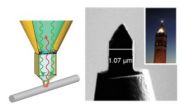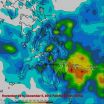(Press-News.org) Researchers from North Carolina State University, the National Institute of Environmental Health Sciences and a host of other institutions have developed a safety testing system to help chemists design inherently safer chemicals and processes.
The innovative "TiPED" testing system (Tiered Protocol for Endocrine Disruption) stems from a cross-disciplinary collaboration among scientists, and can be applied at different phases of the chemical design process. The goal of the system is to help steer companies away from inadvertently creating harmful products, and thus avoid adding another BPA or DDT to the marketplace.
A paper describing the work, "Designing Endocrine Disruption Out of the Next Generation of Chemicals," is published online in the Royal Society of Chemistry journal Green Chemistry.
"In order to reduce our exposure to endocrine disruptors, we have to ensure that new products entering the market do not contain them," says Dr. Heather Patisaul, an associate professor of biology at NC State and co-author of the paper. "The goal of this project is to develop an effective strategy for chemists, engineers, and manufacturers to identify potential endocrine disruptors before they are used in commercial products. Identifying these types of chemicals early in the design process will ultimately help ensure that we develop the safest products possible, which benefits consumers."
The work was conducted by biologists, green chemists and others from North America and Europe who say that recent product recalls and bans reveal that neither product manufacturers nor governments have adequate tools for dealing with endocrine disrupting chemicals (EDCs). EDCs are chemicals commonly used in consumer products that can mimic hormones and lead to a host of modern-day health epidemics including cancers, learning disabilities and immune system disorders.
The authors conclude that as our understanding of the threat to human health grows, the need for an effective testing strategy for endocrine disrupting chemicals becomes imperative.
Historically, chemists have aimed to make products that are effective and economical. Considering toxicity when designing new chemicals has not been their responsibility. This collaboration between fields expands the scope of both biologists and chemists to lead to a way to design safer chemicals.
###
There is a companion website to the paper, www.TiPEDinfo.com. One can access the paper there and learn more about the TiPED system.
The paper was co-authored by researchers from NC State, NIEHS, the University of California, San Diego, the University of California, Irvine, Carnegie Mellon University, University of Texas at Austin, Virginia Commonwealth University, Advancing Green Chemistry, Louisiana Tech University, Medical University of South Carolina, University of California, Berkeley, McGill University, Oregon State University, Tufts University, the Warner Babcock Institute for Green Chemistry, the University of Texas Medical Branch, the University of Missouri–Columbia, the University of Massachusetts-Amherst and Environmental Health Sciences.
Researchers craft tool to minimize threat of endocrine disruptors in new chemicals
2012-12-07
ELSE PRESS RELEASES FROM THIS DATE:
Autistic adults report significant shortcomings in their health care
2012-12-07
PORTLAND, Ore. — Researchers at Oregon Health & Science University (OHSU) have found that adults with autism, who represent about 1 percent of the adult population in the United States, report significantly worse health care experiences than their non-autistic counterparts.
"Like other adults, adults on the autism spectrum need to use health care services to prevent and treat illness. As a primary care provider, I know that our health care system is not always set up to offer high-quality care to adults on the spectrum; however, I was saddened to see how large the disparities ...
Unlocking the genetic mysteries behind stillbirth
2012-12-07
Galveston, Texas — Stillbirth is a tragedy that occurs in one of every 160 births in the United States. Compounding the sadness for many families, the standard medical test used to examine fetal chromosomes often can't pin down what caused their baby to die in utero. In most cases, the cause of the stillbirth is not immediately known. The traditional way to determine what happened is to examine the baby's chromosomes using a technique called karyotyping. This method leaves much to be desired because, in many cases, it fails to provide any result at all. Today, some 25 to ...
Different genes behind same adaptation to thin air
2012-12-07
Highlanders in Tibet and Ethiopia share a biological adaptation that enables them to thrive in the low oxygen of high altitudes, but the ability to pass on the trait appears to be linked to different genes in the two groups, research from a Case Western Reserve University scientist and colleagues shows.
The adaptation is the ability to maintain a relatively low (for high altitudes) level of hemoglobin, the oxygen-carrying protein in red blood cells. Members of ethnic populations - such as most Americans - who historically live at low altitudes naturally respond to the ...
Deception can be perfected
2012-12-07
EVANSTON, Ill. --- With a little practice, one could learn to tell a lie that may be indistinguishable from the truth.
New Northwestern University research shows that lying is more malleable than previously thought, and with a certain amount of training and instruction, the art of deception can be perfected.
People generally take longer and make more mistakes when telling lies than telling the truth, because they are holding two conflicting answers in mind and suppressing the honest response, previous research has shown. Consequently, researchers in the present study ...
Gladstone scientists discover novel mechanism by which calorie restriction influences longevity
2012-12-07
SAN FRANCISCO, CA—December 6, 2012—Scientists at the Gladstone Institutes have identified a novel mechanism by which a type of low-carb, low-calorie diet—called a "ketogenic diet"—could delay the effects of aging. This fundamental discovery reveals how such a diet could slow the aging process and may one day allow scientists to better treat or prevent age-related diseases, including heart disease, Alzheimer's disease and many forms of cancer.
As the aging population continues to grow, age-related illnesses have become increasingly common. Already in the United States, ...
Attitudes predict ability to follow post-treatment advice
2012-12-07
SAN ANTONIO, TX (December 6, 2012)—Women are more likely to follow experts' advice on how to reduce their risk of an important side effect of breast cancer surgery—like lymphedema—if they feel confident in their abilities and know how to manage stress, according to new research from Fox Chase Cancer Center to be presented at the 2012 CTRC-AACR San Antonio Breast Cancer Symposium on Saturday, December 8, 2012.
These findings suggest that clinicians must do more than just inform women of the ways they should change their behavior, says Suzanne M. Miller, PhD, Professor ...
Seeing in color at the nanoscale
2012-12-07
If nanoscience were television, we'd be in the 1950s. Although scientists can make and manipulate nanoscale objects with increasingly awesome control, they are limited to black-and-white imagery for examining those objects. Information about nanoscale chemistry and interactions with light—the atomic-microscopy equivalent to color—is tantalizingly out of reach to all but the most persistent researchers.
But that may all change with the introduction of a new microscopy tool from researchers at the Department of Energy (DOE)'s Lawrence Berkeley National Laboratory (Berkeley ...
Notre Dame research reveals migrating Great Lakes salmon carry contaminants upstream
2012-12-07
Be careful what you eat, says University of Notre Dame stream ecologist Gary Lamberti.
If you're catching and eating fish from a Lake Michigan tributary with a strong salmon run, the stream fish — brook trout, brown trout, panfish — may be contaminated by pollutants carried in by the salmon.
Research by Lamberti, professor and chair of biology, and his laboratory has revealed that salmon, as they travel upstream to spawn and die, carry industrial pollutants into Great Lakes streams and tributaries. The research was recently published in the journal Environmental Science ...
Silver nanocubes make super light absorbers
2012-12-07
DURHAM, N.C. -- Microscopic metallic cubes could unleash the enormous potential of metamaterials to absorb light, leading to more efficient and cost-effective large-area absorbers for sensors or solar cells, Duke University researchers have found.
Metamaterials are man-made materials that have properties often absent in natural materials. They are constructed to provide exquisite control over the properties of waves, such as light. Creating these materials for visible light is still a technological challenge that has traditionally been achieved by lithography, in which ...
NASA compiles Typhoon Bopha's Philippines Rainfall totals from space
2012-12-07
NASA's Tropical Rainfall Measuring Mission, or TRMM satellite can estimate rainfall rates from its orbit in space, and its data is also used to compile estimated rainfall totals. NASA just released an image showing those rainfall totals over the Philippines, where severe flooding killed several hundred people. Bopha is now a tropical storm in the South China Sea.
High winds, flooding and landslides from heavy rains with Typhoon Bopha have caused close to 300 deaths in the southern Philippines.
The TRMM satellite's primary mission is the measurement of rainfall in the ...



